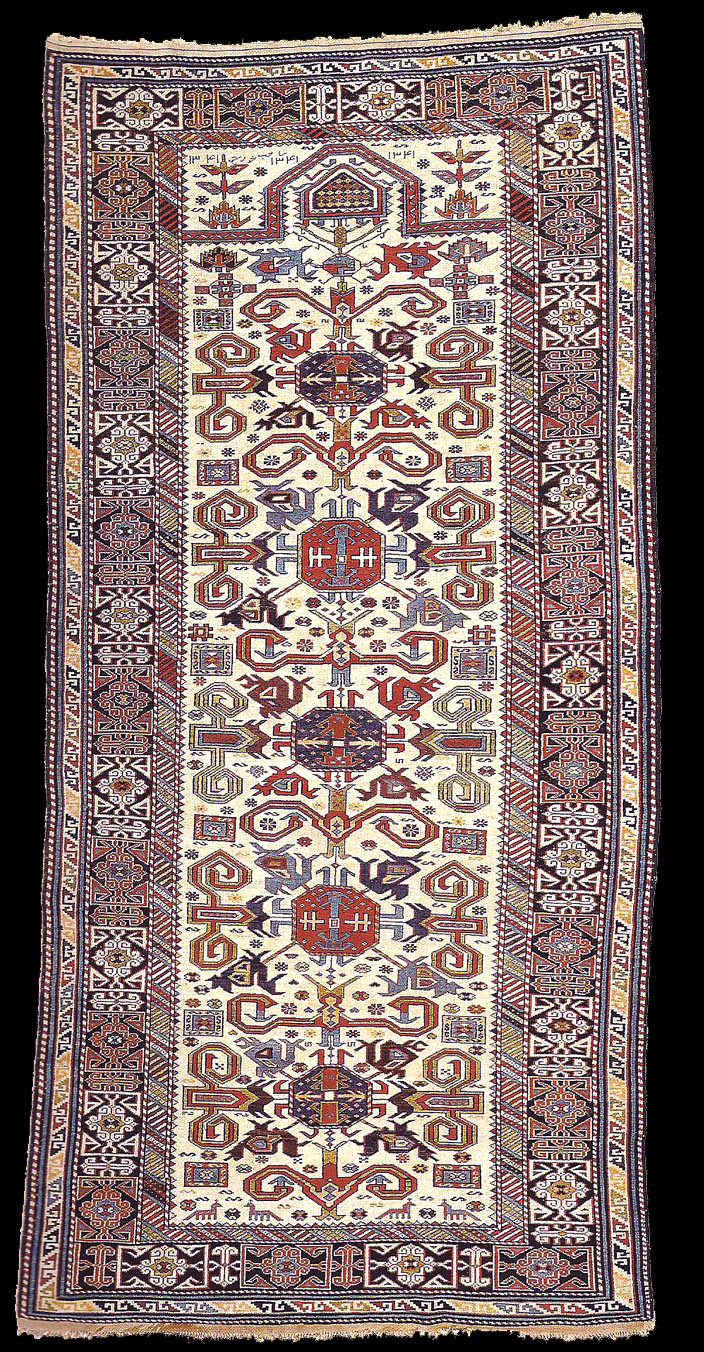|
Pirebadil (so-called Perepedil) Divichi district, Kuba 300 X 143 cm
Dated 1341 = 1922 and inscription: Saheb Khorshid = Khorshid is the owner (Khorshid
means the sun and is also a women's name)
A prayer gable and niche (mihrab) have been woven into the light ground on
the top. Other than this, we see the classical ornamentation of this type.
On the central vertical axis, we can see five octagons (gols) which are
surrounded by four fabulous birds and four fork meanders in two different
versions in a symmetrical arrangement. It is difficult to find out what the
birds are supposed to symbolise. It may well be that they represent the
legendary Simorgh (fabulous bird of Persian mythology). The so-called fork
meanders which are often quoted in references are called buynuz (ram's
horns) in Azerbaijan. 1 could well imagine that one hypothesis does not
necessarily have to rule out the other. That is to say, these varieties
could be both, botanical and zoomorphic. The main border which is known as
the Cufic border is called hashiye shami (border from Sham which is the old
Arab name of Syria). Two narrower borders with colourful diagonal stripes
surround the main border.
Warp: Wool, Z3 S, light ivory.
Wefts: Wool, Z2, ivory and beige, 2 wefts: lil tighter, 2nd waved.
Pile: Wool, Z2, Pile Height: 5.5 mm.
Knots: Symmetrical 3, \,H40xV30 = 1,200 Kn/dm2.
Handle: Velours, almost thin, lightly ribbed. Upper End: c. 4 cm wide light
wool simple tapestry weave; in the centre, four rows of red threads are
inserted.
Lower End: c. 3.5 cm light, slightly looser simple tapestry weave, warps
knotted in groups.
Selvedge: Round light wool shirazi.
Remarks: Pirebadil on a white ground are fairly rare. As we know, white is
the colour that is associated with weddings and also the dowry. Since the
name Khorshid (the sun) is woven into the carpet, we may assume that it was
made by the bride herself for her dowry and she was so proud of it that she
left her fingerprints.
Literature: L. Kerimov I, plate 183; Kerimov II, plate 19, Kerimov IV, plate
45; U. Schiirmann, plate 73, p. 211; R. Wright, plate 32, for Pirebadil with
a white ground, see Doris Eder, plates 372 and 373 on pages 332 and 333.
published at Siyawouch
Azadi "Azerbaijani Caucasian
rugs" plate no: 38
 |

